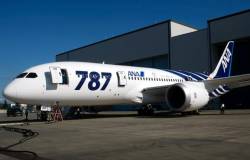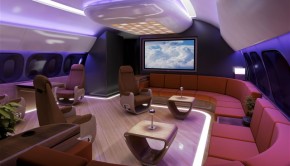Dreamliner Becoming a Nightmare
 Exert From BreakingTraveNews – When the Dreamliner finally took off for its first commercial flight in October 2011 it was already three years behind schedule.
Exert From BreakingTraveNews – When the Dreamliner finally took off for its first commercial flight in October 2011 it was already three years behind schedule.
Now, a little more than a year later, it has been grounded once again, as the Federal Aviation Administration conducts an investigation into a potential fire risk on the new aircraft.
Here we take a look at the development of this benighted project and ask what comes next for manufacturer Boeing.
Dreamliner
With over 800 planes ordered before the first completed aircraft rolled off the production line, the launch of the Boeing 787 Dreamliner appeared to be one of the most successful in aviation history.
Airlines around the world queued up to order the revolutionary new plane.
Made from composite materials, it was significantly lighter than its competitors, allowing for greater fuel efficiency and therefore lower costs. No small feat in these straighten times.
Boeing had also gone all out on the interior, promising cleaner air, a lower cabin altitude, higher humidity, bigger windows and more overhead storage space for passengers.
In short, it seemed like a dream come true for airlines.
But it now seems Boeing – despite spending upward of $32 billion on the project – may have overreached in its ambitions.
A horrendously convoluted supply chain delayed construction of the first Dreamliners and set the whole project back years as the aviation giant sought to untangle the mess, eventually purchasing supplies it had originally outsourced work to.
Early planes also came in overweight, reducing the much vaunted fuel efficiency, and sending designers back to the drawing board to work on some elements of the plane.
Testing was also delayed when an electrical fire forced an emergency landing of a Dreamliner in Texas, while the National Labour Relations Board in the United States alleged a Dreamliner production line in South Carolina violated two sections of the National Labour Relations Act.
The case was later dropped.
Deliverance
Putting all these problems behind it, the Dreamliner was finally delivered to launch customer All Nippon Airways in late 2011.
ANA launched the 787 on its first commercial flight, from Narita to Hong Kong, on October 26th, reporting a 20 per cent drop in fuel consumption, and suggesting to Boeing all the hard work had been worthwhile.
Over the coming months Air India (six aircraft), Ethiopian Airlines (four), Japan Airlines (seven), LAN Airlines (three), LOT Polish Airlines (two), Qatar Airways (five) and United Airlines (six) all took deliveries of the new Dreamliner, while ANA built its fleet to 17 planes.
Demand continued to increase, with Boeing presently expecting to deliver over 800 of the planes to 58 customers over the next decade.
In November last year Boeing increased the production rate of the aircraft to ten per month, up from 8.5, with the project apparently finally gaining traction.
But this honeymoon period now appears to have been short lived.
United Airlines was among the first to report problems, with a Dreamliner flight forced to make an emergency landing because of an electrical problem in December last year.
In the same month Qatar Airways grounded one of its 787 Dreamliners after several manufacturing faults caused electrical problems – similar to those that affected the United plane.
Earlier this month All Nippon Airways reported a crack in the window on the pilot’s side of the cockpit of a Dreamliner, starting a spiral of negative headlines which would culminate in the grounding of the plane.
The same airline later reported another Dreamliner flight, shuttling between Haneda and the southern Miyazaki prefecture, experienced a delay due to an oil leak from a generator inside an engine.
Last Wednesday, ANA again cancelled a 787 flight from Yamaguchi to Tokyo because of a brake problem, while Japan Airlines cancelled a Boston to Tokyo flight after about 40 gallons of fuel spilled during taxiing.
On Monday an electrical fire broke out on board a Japan Airlines Dreamliner, shortly after it landed in Boston, following a flight from Tokyo.
No serious injuries were reported during any of the incidents.
However, the electrical fire appears to have been the final straw, with the Japanese transport ministry launching an investigation. Both ANA and Japan Airlines grounded their fleets.
This lead was followed by the Federal Aviation Authority, which issued an emergency airworthiness directive – requiring all Boeing 787 Dreamliners to temporarily cease operations.
Nightmare
United Airlines, the only US airline currently operating the Dreamliner, said it would immediately comply with the FAA directive and would begin re-accommodating customers on alternative aircraft
In Chile, LAN announced it would suspend its three Dreamliners from service in co-ordination with the Chilean Aeronautical Authority, while Indian aviation regulators ordered Air India to stop operating its 787s.
LOT Airlines of Poland cancelled a return flight from Chicago to Warsaw on Wednesday, with the European Union later calling a suspension to the use of the aircraft.
Qatar Airways said earlier it had grounded the planes and was “actively working with Boeing and the regulators to restore full customer confidence in the 787”, while Ethiopian Airlines was the last to ground its planes.
Quite where this leaves Boeing is yet to be seen.
In a statement, Boeing chairman Jim McNerney defended the aircraft, saying: “Boeing is committed to supporting the FAA and finding answers as quickly as possible.
“The company is working around the clock with its customers and the various regulatory and investigative authorities.
“We are confident the 787 is safe and we stand behind its overall integrity.
“We will be taking every necessary step in the coming days to assure our customers and the travelling public of the 787’s safety and to return the airplanes to service.”
But the outcome of the various international investigations could take days, if not weeks, leaving Boeing to shore up the already battered reputation of the aircraft.
Admissions of teething problems, seen in all new aircraft, appear to be wearing thin, with the manufacturer in need of a new explanation quickly if it is to maintain confidence and prevent orders from being cancelled.
As it stands, however, airlines are lining up to support the aircraft.
One of the most vocal supporters has been Bjorn Kjos, chief executive of Norwegian Air Shuttle, who branded the incidents “minor problems”.
Norwegian has yet to take delivery of the Dreamliner, though the aircraft is vital to its ambitious plan to expand by offering long-haul flights.
UK carrier Thomson Airways is set to be the first British airline to fly the Dreamliner when it takes delivery of the first of eight 787s this spring.
British Airways is due to take delivery of the first of its 24 Dreamliners in May, while Virgin Atlantic is scheduled to start taking the first of 16 Dreamliners in summer 2014.
It remains to be seen whether the present investigations delay these timetables.
End Game
If faults can be found and quickly rectified, Boeing may escape without lasting damage to the Dreamliner project.
Airlines have a tremendous amount invested in the programme themselves and will not be quick to ditch it, not least because the rival Airbus A350 is still years away from launch.
But a worst-case scenario would see regulators discover a serious problem that would require time-consuming work to rectify, delaying future deliveries.
This could see Boeing hit by the demands for compensation it so narrowly avoided during the delayed launch of the Dreamliner.












